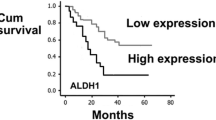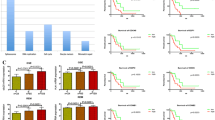Abstract
The relationship between malignant potential and apoptosis in astrocytic tumors has not been clearly defined, and further classification of astrocytic tumors is necessary. To elucidate the relationship between the histopathological grade of astrocytic tumors and apoptosis, we studied 25 cases of astrocytic tumors, comprising 10 cases of glioblastoma (GB), 7 cases of anaplastic astrocytoma (AA), and 8 cases of astrocytoma (AC). We detected apoptosis using the TdT-mediated dUTP-biotin nick-end labeling (TUNEL) method. We studied immunohistochemical expression of bcl-2 protein and p53 protein, which are apoptosis-related factors, and cell proliferative activity using Ki-67 antibody. No significant change was noted between apoptotic index and the histological grade of the tumors. In GB, apoptotic cell-rich foci were present at the pseudopalisading necrosis. No correlation between histopathological grades and expression of either p53 or bcl-2 was observed. In GB, however, poor distribution of bcl-2 was found in the areas of pseudopalisade formation. bcl-2 is one of the regulatory factors in the cell cycle and inhibits apoptosis. Expression of apoptosis had no correlation with histopathological grade. However, in GB, the distribution of apoptotic cells showed a correlation with bcl-2-poor foci. It was thought that apoptosis was one of the regulatory factors in the formation of pseudopalisading necrosis in GB.
Similar content being viewed by others
References
Wyllie AH (1987) Cell death. Int Rev Cytol 17:755–785
Trauth B, Klas C, Peter AMJ, et al (1989) Monoclonal antibodymediated tumor regression by induction of apoptosis. Science 245:301–305
Stewart BW (1994) Mechanisms of apoptosis; integration of genetic, biochemical, and cellular indicators. J Natl Cancer Inst 86:1286–1296
Carson DA, Ribeiro, JM (1993) Apoptosis and disease. Lancet 34:1251–1254
Kobayashi M, Watanabe H, Ajioka Y, et al (1995) Correlation of p53 protein expression with apoptotic incidence in colorectal neoplasia. Virchows Arch 427:27–32
Nakagawa S, Shiraishi T, Kihara S, et al (1995) Detection of DNA strand breaks associated with apoptosis in human brain tumors. Virchows Arch 427:175–179
Hamada M, Naomoto Y, Fujiwara T, et al (1996) Suppressed apoptotic induction in esophageal squamous cell carcinomas expressing extensive p53 protein. Jpn J Clin Oncol 26:398–404
Langlois NEL, Lamb J, Eremin O, et al (1997) Apoptosis in colorectal carcinoma occuring in patients aged 45 years and under: relationship to prognosis, mitosis, and immunohistochemical demonstration of p53, c-myc, and bcl-2 protein products. J Pathol 182:392–397
Koshida Y, Saegusa M, Okayasu I (1997) Apoptosis, cell proliferation and expression of bcl-2 and Bax in gastric carcinomas: imunohistochemical and clinicopathological study. Br J Cancer 75:367–373
Gavrielli Y, Sherman Y, Ben-Sasson SA (1992) Identification of programmed cell death in situ via specific labeling of nuclear DNA fragmentation. J Cell Biol 119:493–501
Reed JC (1994) Bcl-2 and the regulation of programmed cell death. J Cell Biol 124:1–6
Shaw P, Bovey R, Tardy S, et al (1992) Induction of apoptosis by wild-type p53 in a human colon tumor-derived cell line. Proc Natl Acad Sci 89:4495–4499
Ellison DW, Streart PV, Gatter KC, et al (1995) Apoptosis in cerebral astrocytic tumours and its relationship to expression of the bcl-2 and p53 proteins. Neuropathol Appl Neurobiol 21:352–361
Gerdes J, Schwab U, Lemke H, et al (1983) Production of mouse monoclonal antibody reactive with a human nuclear antigen associated with cell proliferation. Int J Cancer 31:13–20
Kleihues P, Burger PC, Scheithauer BW (1993) Histological typing of tumors of the central nervous system. World Health Organization, Springer Verlag
Piazza GA, Rahm ALK, Krutzsch M, et al (1995) Antineoplastic drugs sulndac sulfide and sulfone inhibit cell growth by inducing apoptosis. Cancer Res 55:3110–3116
Burger PC, Scheithauer BW (1994) Tumors of the central nervous system. Atlas of tumor pathology, 3rd series, Frascile 10, Armed Forces Institute of Pathology, Washington, DC
Tohma Y, Gratas C, van Meir EG, et al (1998) Necrogenesis and FAS/APO-1 (CD95) expression in primary (de novo) and secondary glioblastomas. J Neuropathol Exp Neurol 57:239–245
Louis DN (1994) The p53 gene and protein in human brain tumors. J Neuropathol Exp Neurol 53:11–21
Takekawa Y, Sawada T (1998) Vascular endothelial growth factor and neovascularization in astrocytic tumors. Pathol Int 48:109–114
Manz R, Otte J, Thews G, et al (1983) Relationship between size and oxygenation status of malignant tumors. Adv Exp Med Biol 159:391–398
Tachibana O, Lampe J, Kleihues P, et al (1996) Preferential expression of FAS/APO1 (CD95) and apoptotic cell death in perinecrotic cells of glioblastoma multiforme. Acta Neuropathol 92:431–434
Graeber TG, Osmanian C, Jacks T, et al (1996) Hypoxia-mediated selection of cells with diminished apoptotic potential in solid tumors. Nature 379:88–91
Author information
Authors and Affiliations
Rights and permissions
About this article
Cite this article
Takekawa, Y., Sawada, T. & Sakurai, I. Expression of apoptosis and its related protein in astrocytic tumors. Brain Tumor Pathol 16, 11–16 (1999). https://doi.org/10.1007/BF02478896
Received:
Accepted:
Issue Date:
DOI: https://doi.org/10.1007/BF02478896




